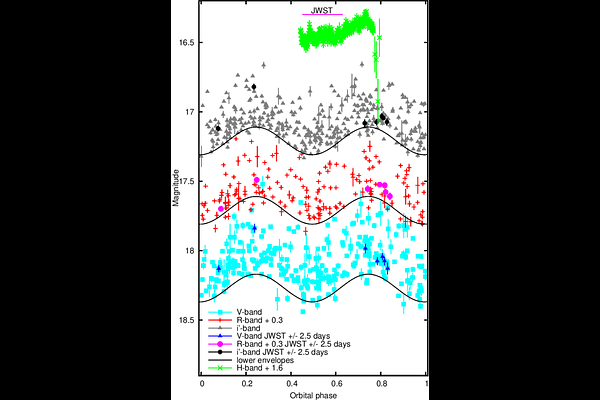Gone with the Wind: JWST-MIRI Unveils a Strong Outflow from the Quiescent Stellar-Mass Black Hole A0620-00

Gone with the Wind: JWST-MIRI Unveils a Strong Outflow from the Quiescent Stellar-Mass Black Hole A0620-00
Zihao Zuo, Gabriele Cugno, Joseph Michail, Elena Gallo, David M. Russell, Richard M. Plotkin, Fan Zou, M. Cristina Baglio, Piergiorgio Casella, Fraser J. Cowie, Rob Fender, Poshak Gandhi, Sera Markoff, Federico Vincentelli, Fraser Lewis, Jon M. Miller, James C. A. Miller-Jones, Alexandra Veledina
AbstractWe present new observations of the black hole X-ray binary A0620-00 using the Mid-Infrared Instrument on the James Webb Space Telescope, during a state where the X-ray luminosity is 9 orders of magnitude below Eddington, and coordinated with radio, near-infrared and optical observations. The goal is to understand the nature of the excess mid-infrared (MIR) emission originally detected by Spitzer red-ward of 8 $\mu$m. The stellar-subtracted MIR spectrum is well-modeled by a power law with a spectral index of $\alpha=0.72\pm0.01$, where the flux density scales with frequency as $F_\nu \propto \nu^{\alpha}$. The spectral characteristics, along with rapid variability--a 40% flux flare at 15$\mu$m and 25% achromatic variability in the 5-12 $\mu$m range--rule out a circumbinary disk as the source of the MIR excess. The Low Resolution Spectrometer reveals a prominent emission feature at 7.5 $\mu$m, resulting from the blend of three hydrogen recombination lines. While the contribution from partially self-absorbed synchrotron radiation cannot be ruled out, we argue that thermal bremsstrahlung from a warm (a few $10^4$ K) wind accounts for the MIR excess; the same outflow is responsible for the emission lines. The inferred mass outflow rate indicates that the system's low luminosity is due to a substantial fraction of the mass supplied by the donor star being expelled through a wind rather than accreted onto the black hole.